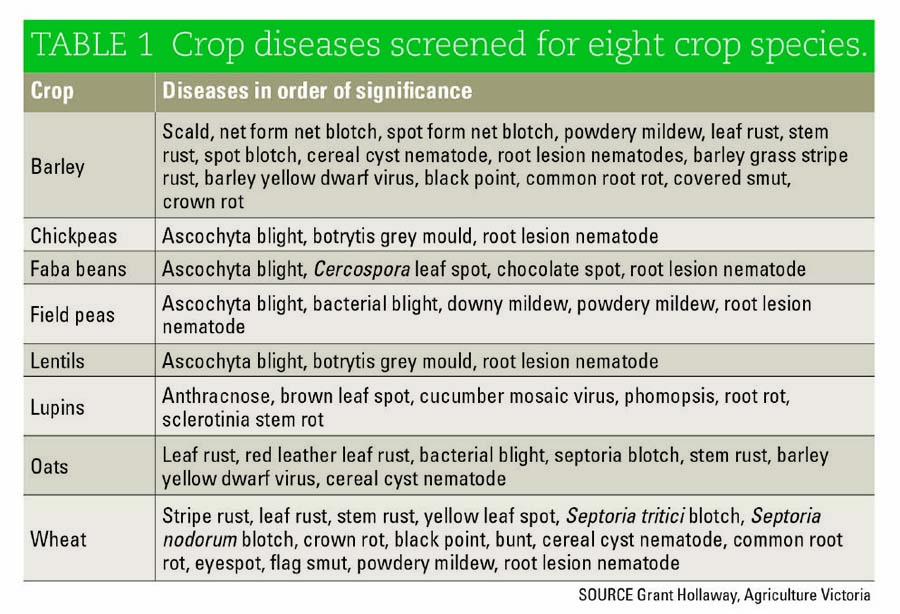Key points
- NVT now includes independent disease ratings for oats, pulses, wheat and barley, as well as blackleg for canola
- Select varieties with the highest disease rating for the disease of importance in your region together with yield, quality and other traits
Along with yield and quality performance, disease ratings are used to inform varietal selection, and are also used in guiding in-crop disease management during the growing season.
Through GRDC's National Variety Trial (NVT) program, independent disease ratings have been provided to industry on all new and current wheat and barley cultivars over the past 10 years. With new investment by GRDC, this rating system has expanded to include oats and pulses (field peas, lentils, lupins, faba beans and chickpeas).
This will provide growers with more reliable data to inform variety selection of these species and in-crop disease management.
During 2019, data is being collected on several crop diseases from different field or controlled environment screens on eight crop species.
Disease ratings are based on a nine-point scale ranging from 'resistant' to 'very susceptible'. Resistant lines do not show symptoms of the disease and therefore do not suffer yield losses, whereas very susceptible lines are prone to extensive damage when both the disease and suitable conditions are present.
When selecting varieties growers should choose those with the highest level of resistance to relevant diseases in their region, together with yield, quality and other traits.
National coordination
A coordinated team of disease experts across the nation contributes to the disease-screening work of the NVT.
Expert personnel - from Agriculture Victoria, the South Australian Research and Development Institute, Department of Primary Industries and Regional Development (Western Australia), New South Wales Department of Primary Industries, University of Southern Queensland, Queensland Department of Agriculture and Fisheries, Marcroft Pathology, and the University of Sydney - undertake a concerted disease-screening effort to ensure new cultivars are tested against regionally relevant strains of disease.
This results in disease ratings of regional relevance Australia-wide.
Screening methods
Varietal disease ratings are generated through the use of field and/or glasshouse screens conducted in a range of locations. In a typical field-based disease nursery, both current cultivars and NVT test lines (new cultivars before release) are sown as single short rows along with spreader lines (lines highly susceptible to the target disease but resistant to non-target diseases) and control lines with a known range of resistance-susceptibility to the target disease.
Target diseases are introduced through selecting sowing dates to favour the disease, and in the cases of some diseases, selective fungicides may be used to exclude non-target disease development. Infected stubble or spores may be applied to generate diseases and supplementary irrigation used to enhance disease infection.
During 2019, data is being collected on several crop diseases from different field or controlled environment screens on eight crop species (Table 1).
Scoring and delivering ratings
When sufficient disease has developed in nurseries to distinguish between resistant and susceptible lines, a skilled plant pathologist, using agreed assessment protocols, undertakes a visual assessment of disease levels on each row in the field.
Data is compiled from each trial at the end of the season and a summary rating applied for each disease and line.
This information is submitted to the NVT database and combined with data from the other screens conducted nationally for each disease.
As diseases can change over time as new strains develop, it is always important to consult a current disease guide to ensure the most recent ratings are used.
Pathology experts then meet to discuss the rankings and, depending on the range of strains (pathotypes) of disease present across Australia, either a single national rating is determined if there is no variation in ratings, or a different rating allocated for each state if necessary.
Disease ratings for each crop are published in state-based disease guides and are available.
As diseases can change over time as new strains develop, it is always important to consult a current disease guide to ensure the most recent ratings are used.
More information: Dr Grant Hollaway, 03 4344 3111, Grant.Hollaway@ecodev.vic.gov.au


























































